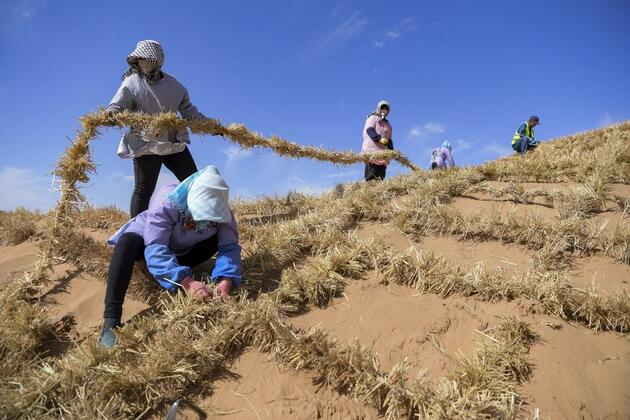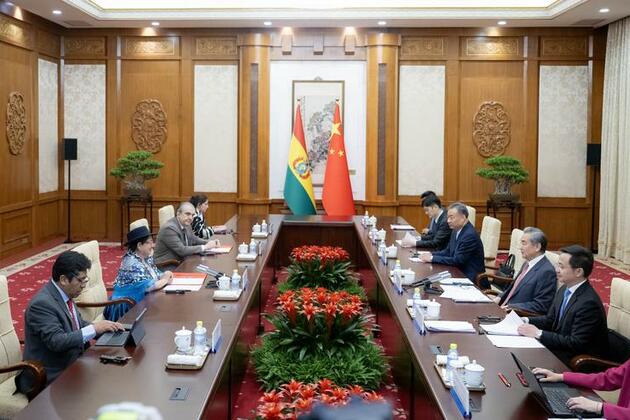China completes barrier belt to prevent eastward expansion of its fourth-largest desert
Xinhua
01 Jul 2025, 07:18 GMT+10

YINCHUAN, July 1 (Xinhua) -- China on Monday reached a major milestone in desertification control by completing a barrier belt along the southeastern edge of the Tengger Desert in the northwestern Ningxia Hui Autonomous Region.
In Changliushui village in the city of Zhongwei, workers installed the final row of straw checkerboards, a traditional sand-fixing method, locking the final stretch of shifting dunes in the Ningxia part of the Tengger Desert after a sand control project spanning more than six decades.
This traditional sand-fixing method involves planting straw in a checkerboard pattern on the desert surface to stabilize sand and prevent wind erosion.
This new achievement marks the completion of a 153-kilometer-long green barrier belt in Ningxia, which is 10 to 38 kilometers wide.
Called simply the desert edge-locking project, this approach was designed to fix shifting dunes by planting vegetation belts along the desert's perimeter, preventing further encroachment.
Sand control often suffers setbacks as fixed dunes can start to shift again. To prevent this, workers plan to sow grass and desert-adapted shrubs within the checkerboard grid once the rainy season arrives. Once rooted, the vegetation is expected to lock the sand for the long term.
The belt serves as a natural defense line against the eastward spread of the Tengger Desert, which spans approximately 43,000 square kilometers.
Zhongwei, located between the Qilian and Helan mountains, is the sole gateway for the Tengger Desert's eastward expansion. Experts say the barrier will act as a critical ecological buffer that prevents further sand encroachment and protects the Yellow River.
Lu Qi, chief scientist of the Chinese Academy of Forestry, said the barrier belt can help prevent the desert from further encroaching on farmland, towns, oases and roads, and also significantly reduce the source of sandstorms.
The construction of the green barrier belt in Ningxia dates back to the 1950s when the straw checkerboard approach was invented to protect the Baotou-Lanzhou Railway, China's first desert railway.
Local authorities have worked with research institutions to apply new technologies in sand control, such as artificial cyanobacteria sand crusts and improved straw checkerboards.
Over the past two years, 2.6 billion yuan (about 363 million U.S. dollars) of investment has been made in the construction of the green barrier belt, part of China's Three-North Shelterbelt Forest Program, the world's largest afforestation program to tackle desertification.
After generations' sand control efforts over the past decades, the city has finished desertification control on about 370,000 hectares of land, pushing the desert back by about 25 kilometers.
"The green barrier belt is not only a means of ecological restoration, but also a key practice of harmonious coexistence between humankind and nature," said Lu. "It also offers an important reference for the sustainable development of arid areas worldwide."
China has taken an active role in global desertification control. Since signing the United Nations Convention to Combat Desertification in 1994, the country has been a leader in halting land degradation and reversing desertification, and has continuously shared sand control experience, technologies and talent abroad.
In its latest effort, the China-Central Asia desertification control cooperation center, which is based in Ningxia, was inaugurated in June to boost international collaboration.
"Our goal is to inject more Chinese momentum into global ecological governance and sustainable development," said Dong Yanbiao, deputy director of the center. He added that the center plans to leverage technology advantages, integrate domestic research and build cooperation networks.
 Share
Share
 Tweet
Tweet
 Share
Share
 Flip
Flip
 Email
Email
Watch latest videos
Subscribe and Follow
Get a daily dose of Chile Sun news through our daily email, its complimentary and keeps you fully up to date with world and business news as well.
News RELEASES
Publish news of your business, community or sports group, personnel appointments, major event and more by submitting a news release to Chile Sun.
More InformationSouth America
SectionPERU-CUSCO-INTI RAYMI-INCA FESTIVAL
(250701) -- CUSCO, July 1, 2025 (Xinhua) -- This photo taken on June 20, 2025 shows people celebrating Inti Raymi, or the Festival...
ARGENTINA-BUENOS AIRES-YPF-U.S.-RULING-APPEAL
(250701) -- BUENOS AIRES, July 1, 2025 (Xinhua) -- This photo taken on June 30, 2025 shows a YPF logo in Buenos Aires, Argentina. Argentina...
"Super Premium Frequent Flier PM...": Cong MP Jairam Ramesh attacks PM Narendra Modi ahead of his 5-nation visit
New Delhi [India], July 1 (ANI): Congress MP Jairam Ramesh took a jibe at Prime Minister Narendra Modi on Tuesday, ahead of his five-nation...
Interview: Bolivia values brotherhood with China, says FM
Both Bolivia and China share a firm commitment to defending multilateralism and upholding the vision of the Global South, Bolivian...
(SP)U.S.-CHARLOTTE-FOOTBALL-FIFA CLUB WORLD CUP-FC INTER MILAN VS FLUMINENSE FC
(250701) -- CHARLOTTE, July 1, 2025 (Xinhua) -- Thiago Silva (top) of Fluminense FC celebrates for the goal of teammate Hercules during...
PM Modi to address Parliaments of Ghana, Namibia, Trinidad &Tobago during 5-nation visit : MEA
New Delhi [India], July 1 (ANI): Ahead of Prime Minister Narendra Modi's 5-nation visit, senior officials from the Ministry of External...
World
SectionWestern Sydney raid results in seizure of $25 Million in drugs
SYDNEY, NSW, Australia - , Australian Federal Police (AFP) have shut down a secret drug lab in Sydney's west and seized more than 100kg...
Musk would probably have to close up shop and head back home: Trump takes aim at Tesla CEO over EV mandate, subsidies
Washington, DC [US], July 1 (ANI): US President Donald Trump on Tuesday (local time) claimed that Tesla CEO Elon Musk's business would...
"No yielding to nuclear blackmail, no impunity to terrorists...": Jaishankar reiterates India's stance on terrorism
Washington, DC [US], July 1 (ANI): External Affairs Minister S Jaishankar on Tuesday said that India is not going to yield to nuclear...
U.S. companies leverage China's market, supply chain, innovation boom
TIANJIN, July 1 (Xinhua) -- As a barometer of global economic shifts and industrial transformation, the 2025 Summer Davos Forum held...
"Super Premium Frequent Flier PM...": Cong MP Jairam Ramesh attacks PM Narendra Modi ahead of his 5-nation visit
New Delhi [India], July 1 (ANI): Congress MP Jairam Ramesh took a jibe at Prime Minister Narendra Modi on Tuesday, ahead of his five-nation...
"Trend lines of India-US bilateral ties very positive": Jaishankar expresses hope for successful trade-deal
Washington, DC [US], July 1 (ANI): External Affairs Minister S Jaishankar has hailed the relationship between India and the US, particularly...












